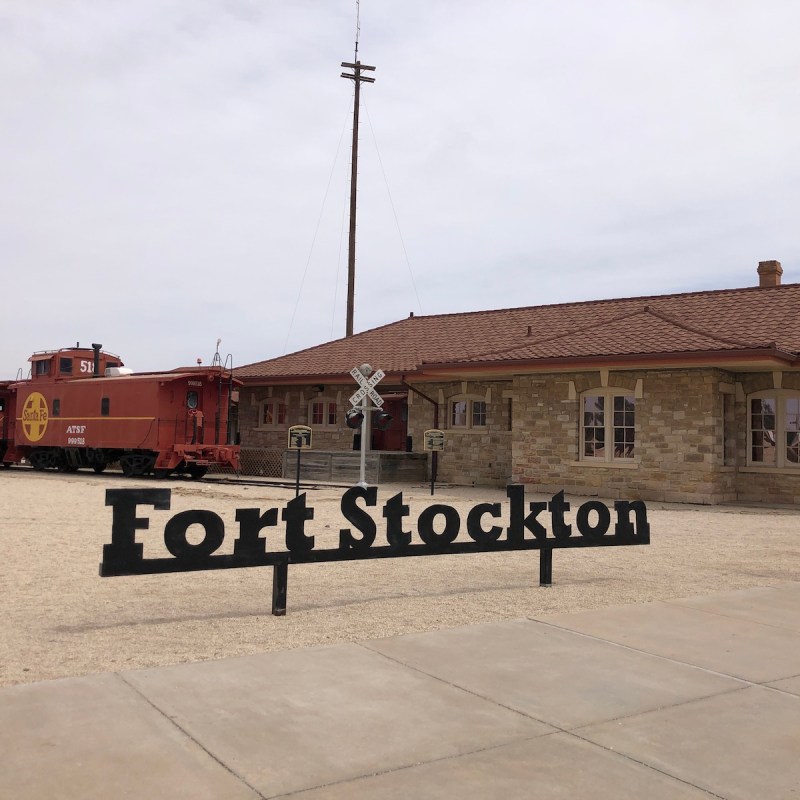
With historic ties to both the Union and Confederate armies, as well as to the regiments of Buffalo Soldiers formed in their wake, Fort Stockton offers a fascinating glimpse into the Lone Star State’s role in the U.S. Civil War.
Videos by TravelAwaits
A historic fort still stands in the small West Texas city of Fort Stockton. Over the turbulent years of the late 1850s and early 1860s, the then-military post changed hands from the Union Army to Confederate forces and then back again to the U.S. Army. Fort Stockton would later serve as the first home of the 9th Cavalry, an original regiment of African American soldiers formed after the war in an attempt to “increase and fix the Military Peace Establishment of the United States,” according to a post-Civil War act of Congress.
In addition to its rich military history, modern-day Fort Stockton features a quirky mix of early Texas settler culture, a robust Tex-Mex cuisine scene, oilfield history, and captivating tales of law enforcement in the rough-and-tumble late 19th/early 20th century in Texas Big Bend Country.
For me, the mash-up of history and culture made for a unique destination on a road trip along the West Texas stretch of Interstate 10. When I stopped to explore Fort Stockton on that April drive from Austin to El Paso, I found a wind-swept, somewhat spread-out town that was bursting with Texas authenticity.
Here are eight unique spots to visit in historic Fort Stockton.

1. Old Kansas City, Mexico And Orient Railroad Depot
Any visit to Fort Stockton should begin at the visitor center, which is housed in the original 1911 Kansas City, Mexico and Orient Railroad Depot. A walk through the building will yield not just informational brochures about area attractions, but also an opportunity to take in the beautifully restored early-1900s train depot
Located not far from Interstate 10 along East Railroad Avenue, the Fort Stockton Visitor Center is surrounded by grounds that offer a treasure trove of information about the region. An assortment of interpretive signs and cutout sculptures tell the story of various aspects of Fort Stockton’s history. You’ll find signs on everything from the oil and gas industry in Pecos County, to the early vaqueros (cowboys) on the open range to the settlers who arrived in “prairie schooner” covered wagons.
The story of the railroad itself is intriguing as well. Historical accounts note that the railroad was conceived as being the shortest route from major U.S. cities — like Kansas City, Houston, and Dallas — to the Pacific Coast, at the Mexican Gulf-of-California town of Topolobampo. Through that port, the railroad was envisioned to one day link Kansas City, by steamship, with China and India (hence the Orient reference) — a dream that was never fulfilled.
Pro Tip: Along with all of the information that is available, the visitor center makes a convenient place to stop, park, and take a walk around the historic center of Fort Stockton.

2. Historic Fort Stockton
Just a few blocks from the visitor center is the town’s namesake site, Historic Fort Stockton, the military fort that was built in 1867 after the original 1858 Camp Stockton had fallen into disrepair. Visitors to the fort can tour several of the original officers’ quarters and guardhouse, as well as two enlisted men’s barracks and kitchens that were re-created by the town of Fort Stockton.
The U.S. Army withdrew from Texas during the Civil War and abandoned Camp Stockton in 1861, after which Confederate troops briefly occupied the site until they too withdrew. By the end of the war, little remained of the first post, and in 1867, Colonel Edward Hatch, Commander of the 9th Cavalry, re-established Fort Stockton at its present location.
The 9th cavalry was one of the original Buffalo Soldiers regiments established after the Civil War. The 9th was joined by the 24th and 25th Infantry Regiments, and later by the 10th Cavalry Regiment. The regiments reportedly were named “Buffalo Soldiers” by the Comanche and Apache people they encountered while protecting the fort.
Until 1886, the post protected travelers and settlers on the numerous roads and trails that made use of the abundant water supply that was available at Fort Stockton’s Comanche Springs. Today, visitors to the fort can browse informative displays depicting the lives of the early frontier soldiers.
Pro Tip: On the third weekend in October, Historic Fort Stockton conducts an annual Living History Day, which includes re-enactments of frontier military history.
3. Annie Riggs Memorial Museum
Occupying the building that served as one of Fort Stockton’s early hotels, the Annie Riggs Memorial Museum stands near the site of the historic fort and the community’s crucial water source of Comanche Springs.
The adobe brick building, with its wrap-around verandas and gingerbread trim, offers an intimate look into the heritage of Fort Stockton, and also of Annie Riggs herself, one of West Texas’s early businesswomen.
Built in 1899 as the Koehler Hotel, the structure was purchased in 1904 by Annie Frazier Johnson Riggs, an enterprising woman who went into the boarding-house business after her second husband was shot and killed in a gunfight. The hotel, which she renamed the Riggs Hotel and operated as a boarding house, served as income for Annie until her death in 1931. The building was later deeded to the Fort Stockton Historical Society, which opened it as a museum memorializing life in the Old West.

4. Paisano Pete Road Runner
Roadrunners are famous throughout the Southwest, but perhaps none more so than Paisano Pete, a whimsical 11-by-22-foot sculpture that has greeted visitors to Fort Stockton for decades.
The statue, which is located across the street from the Fort Stockton Visitor Center, is one of the town’s most photographed attractions, and it’s easy to see why when you stand next to the playful roadrunner likeness. Appearing to be in perpetual motion, Paisano Pete perfectly conjures up the frenetic pace of the bird that can be seen scampering across roads all over West Texas.
Paisano Pete makes for a fun stop on a tour of Fort Stockton and is irresistible as a subject for a selfie or two.
5. Pecos County Historical Jail
As one of the oldest structures in town, the Pecos County Historic Jail has a riveting story to tell. Built in 1883 and enlarged in 1913, the jail is located on the south side of the courthouse square in Fort Stockton, the Pecos County seat.
Today, the old jail serves as a museum of local sheriffs and law enforcement, but 125 years ago it was a hotbed of Old West drama. According to the Texas Historical Association, the jail was overseen in the late 1800s and early 1900s by two notorious sheriffs — one, Sheriff A.J. Royal, who was murdered in his courthouse office in 1894, and another, Sheriff “Dud” Barker, who was voted out of office in a bitter election in 1926 after serving as sheriff for 22 years.
To this day, “Who killed Sheriff Royal?” remains one of the great mysteries of Pecos County, according to information from the Annie Riggs Memorial Museum. Modern-day visitors to the jail can immerse themselves in the intrigue, walking where past sheriffs walked and visiting the original 1883 holding cell and mid-20th century cell blocks.
6. Comanche Springs Pool And Pavilion
During Fort Stockton’s hot summer months (featuring average high temperatures in the 90-degree range from May through August), the Comanche Springs Pool and Pavilion offers both a refreshing respite and a piece of regional history.
In Fort Stockton’s early days, Comanche Springs was an oasis in the desert, providing water for Native American people, Spanish explorers, and early settlers. In 1936, a pavilion/bathhouse was built by the Great Depression-era Works Progress Administration (WPA) to serve the natural pool that formed at the springs.
In the early 1960s, however, the springs, along with the pools and creeks they fed, quit flowing — reportedly because of intensive groundwater pumping upstream — and a municipal pool was built in place of the natural pool. Today, even though the pool is no longer fed by natural springs, visitors can still take in the historic pavilion and bathhouse. The pool is open seasonally in the summer months.
7. Authentic Mexican Cuisine And Steak Houses
Fort Stockton rightfully has a reputation as a spot for excellent Mexican and Tex-Mex cuisine. The Visit Fort Stockton website lists nearly 20 restaurants and food trucks that offer menus with countless variations of burritos, tacos, and enchiladas.
Among the standouts are Tacos OJ, known for its huge selection of taco fillings, such as beef brisket, pork al pastor, and beef barbacoa; and Mi Casita, where chile rellenos and smothered burritos are among the favorites.
Fort Stockton is also home to a number of steakhouses, including K-Bob’s Steakhouse, known for its chicken-fried steak and variety of steak cuts, and the Steak House Restaurant, which features both steaks and Mexican cuisine.

8. Downtown Fort Stockton Driving Tour
The Downtown Fort Stockton Driving Tour is a handy compilation of 16 of the community’s notable spots. Along with prominent attractions like the visitor center and historic fort, it also includes significant historic sites like the Grey Mule Saloon and the Old School and Army Telegraph Office.
Pro Tip: Fort Stockton has a number of chain motels and RV parks available for an overnight stay. The I-10 community also makes a good day-trip option from nearby Big Bend Country towns like Marathon and Alpine.
For more can’t-miss stops in the great state of Texas, consider:
